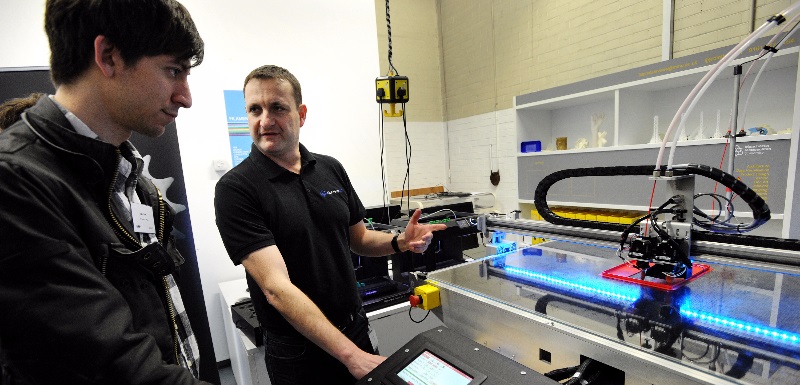![3D Printing Training [Source: Manchester Metropolitan University ]](https://fabbaloo.com/wp-content/uploads/2020/05/printcity_img_5eb08f202d2fa.jpg)
Two of the biggest conversations in 3D printing today have a lot in common.
One of the best parts of my job is that I spend a lot of time talking about 3D printing. I don’t mean that lightly; it’s a lot. From events and networking to regular phone chats to daily (constant) emails and social media — sure, we’ll stick with “a lot”.
In all these discussions, certain trends appear. This will happen anytime you dedicate a significant amount of time to any single subject, so on that count 3D printing isn’t necessarily a special snowflake. But a second highlight of what we do here is sharing those trends and so broadening the conversation.
In the last few weeks (beyond as well, but with increasing frequency) two topics have dominated a lot of my conversations in 3D printing: application-specific solutions, and training.
These two have more in common than it might seem at first blush.
Application-Specific 3D Printing
3D printing is an increasingly market-ready solution. Or should that be markets-ready?
A 3D printer is itself a tool for a job, comparable to any tool used in manufacturing from a hammer to an injection molding line: it can only do what its operator tells it to do, but its actual capabilities are many.
But when a 3D printer (or material, or software suite) is developed with a single use in mind, all its parameters can be geared directly toward the results desired for that use. A high-temperature 3D printer for high-strength polymer end-use parts production will need different functionality than a resin 3D printer intended for use in an in-office dental lab, for example.
Medical 3D printing in particular is seeing a big uptick in interest right now. Introductions just within the last couple of months include Kumovis’ clean-room capable 3D printer and Stratasys’ Digital Anatomy J750 3D printer — both of which also take an ecosystem approach for a full solution.
On the dental side, we’re also seeing a rise in workflows and strategies devoted to need-specific 3D printing.
Go beyond these and it’s a similar story for other major verticals: manufacturing, automotive, aerospace, even art.
Education
But who’s making and operating these 3D printers? Perhaps more importantly: who will be next?
Training, upskilling, education: there’s a lot of focus today on the next generation of 3D printing. And that is perhaps one of the biggest indicators of a nascent industry on a significant growth trajectory — it’s here to stay and will need that next generation.
When does education in 3D printing start? When should it start?
Exposure is starting young — as young as kindergarten. (Or earlier; my due-next-month baby has already received his first 3D printed gift.) Young ones aren’t phased by a 3D printer in their classroom, growing up with the technology and gaining familiarity through the course of their elementary education. Where I took shop class in middle school and engraved my name on a plastic keychain, today’s middle schoolers are 3D printing their keychains. High schools are moving into more rigorous technical training, and then higher education is becoming a huge focus for additive manufacturing with coursework and advanced degrees popping up with increasing regularity.
What about those already in the workforce?
Upskilling is the name of the game here, as engineers, designers, architects, lab technicians, and any number of other career paths are opening up to training in a variety of aspects of additive manufacturing.
Most often these involve design for additive manufacturing (DfAM), to learn to design old parts in a new way to take advantage of geometries not previously possible — but that is by no means the end-all-be-all of 3D print training.
Whether a day-long introductory seminar or a PhD-track course, a wide variety of educational opportunities are popping up with increasing frequency.
And that’s brilliant.
The market will soon be welcoming even more really promising opportunities to guide the next generation of the workforce into a straight career path into 3D printing, eschewing the somewhat less-direct paths this generation has had to take.
Converging Trends
So how do these trends come together?
The way I see it, it’s a natural dovetailing. The more people who are trained in the more technologies, the more solutions can naturally develop. Familiarity with a technology will lead into an organic progression to find the right solution to a given problem.
Having a broad base of knowledge in additive manufacturing will lead a person to see AM as a potential fit to an existing issue. Having deeper knowledge in a specific process will lead to developing ways that method can be applied.
Someone who knows DED 3D printing well might be best able to propose that technology as a fit for rebuilding worn-down industrial components. Someone with a solid SLA understanding may help apply a particular format to a safe lab- or office-based medical solution. Materials scientists will know what formulations are available or could be made to fit a particular need.
In short, it’s the obvious: knowing the options opens up the menu to find the right fit. And understanding those options opens up the ability to actually apply them.
Applying specific knowledge is a natural step toward application-specific solutions.
These two trends will only continue to converge as industries recognize the viability of 3D printing — and I don’t expect conversations in these areas to quiet down anytime soon.

